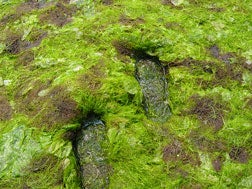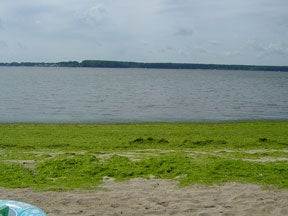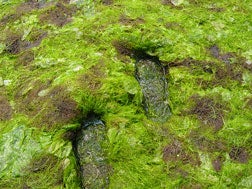 KINGSTON, R.I. – March 9, 2016 – Much like the sudden onslaught of weeds overtaking your garden, algal blooms can rapidly transform from coastal nuisance to massive ecosystem threat. Groundbreaking research from scientists at the University of Rhode Island and Salve Regina University reveals critical new details about the life cycle of these macroalgal blooms that will aid in better management and protection of important coastal resources.
KINGSTON, R.I. – March 9, 2016 – Much like the sudden onslaught of weeds overtaking your garden, algal blooms can rapidly transform from coastal nuisance to massive ecosystem threat. Groundbreaking research from scientists at the University of Rhode Island and Salve Regina University reveals critical new details about the life cycle of these macroalgal blooms that will aid in better management and protection of important coastal resources.
Reported last week in the journal PLOS ONE, the findings detail two separate life history phases of Ulva compressa and Ulva rigida — two common species of seaweed or sea lettuce in Rhode Island’s Narragansett Bay — present during harmful bloom episodes.
“If you are trying to figure out how to control algal blooms, you need to know what part of the life cycle is causing problems,” said Carol Thornber, URI associate professor of biological sciences and the principal investigator for the Rhode Island Experimental Program to Stimulate Competitive Research (EPSCoR). “This gives us a much better understanding of how these blooms reproduce, which gives us insight into blooms in other parts of the world.”
In 2008, in one of the most prominent global outbreaks, a massive green tide deemed the world’s largest macroalgal bloom choked the Chinese coast of Qingdao, the host city for the Olympic sailing competition. The episode demonstrated the devastating effect macroalgal blooms can have on coastal health and marine ecosystems, with economic reverberations that ripple well beyond local and state boundaries.
 In addition to making coastal waters impassable for beachgoers, boaters, and fishermen, Thornber said the massive blooms wreak havoc on the ecosystem when they die. As the massive green mats wash up on beaches and take over shallow areas, they block needed sunlight and deplete oxygen in the water column, setting off a chain reaction that kills sea life and forms dead zones.
In addition to making coastal waters impassable for beachgoers, boaters, and fishermen, Thornber said the massive blooms wreak havoc on the ecosystem when they die. As the massive green mats wash up on beaches and take over shallow areas, they block needed sunlight and deplete oxygen in the water column, setting off a chain reaction that kills sea life and forms dead zones.
Thornber, an ecologist, collaborated on the project with geneticist and developmental biologist J.D. Swanson, associate professor at Salve Regina University. With seed funding for their project from the Rhode Island Science and Technology Advisory Council, the team included URI graduate student Elaine Potter, lead author on the journal article, and URI and SRU undergraduates.
Data collected from sites in Greenwich Bay, which has been monitored monthly since 2005, indicated the location and spread of the blooms throughout the growth cycle. Genetic analysis by Swanson and Potter using an EPSCoR flow cytometer defined the life stages of the alga.
The researchers found that both species of Ulva spend periods of time in one of two phases, either haploid, with one copy of its genome, or diploid, with two copies. During the summer months, the two species presented both life phases, but in different abundance.
Ulva compressa was found to be prevalent throughout June, July and August with a predominance of gametophytes, the haploid phase, during the waxing and waning months of June and August. Heading into the height of bloom season in July, gametophytes and sporophytes, the diploid phase, appeared in equal abundance.
For Ulva rigida, gametophytes figured predominantly throughout the June to August bloom season.
Potter, who completed the monthly surveys and collected the Ulva samples, said that when she ran her first successful samples through the flow cytometer, some contained about double the amount of fluorescence as the others: “I thought, ‘Does this mean that some samples are haploid and some are diploid?’ It turned out that was the case.”
Swanson, who presented the team’s findings at a November 2015 conference in China, said the Rhode Island team has accumulated an advanced data set on Ulva.
The next step lies in designing DNA markers to track individual blooms. Even though the work is confined to the two Ulva species, the results are applicable to a broader field. For example, if there is an edible species that you want to encourage to grow, the team’s genetic work identifies the pathways to fire up development.
Pictured above
1. Macroalgal blooms cover a beach in Greenwich Bay. As the massive green mats wash up on beaches and take over shallow areas, they block needed light and deplete oxygen in the water column.
2. A close-up of macroalgal blooms shows a variety found in the waters of Narragansett Bay, including the Ulva compressa and Ulva rigida species studied by the research team.
(Credit: URI Thornber lab)

